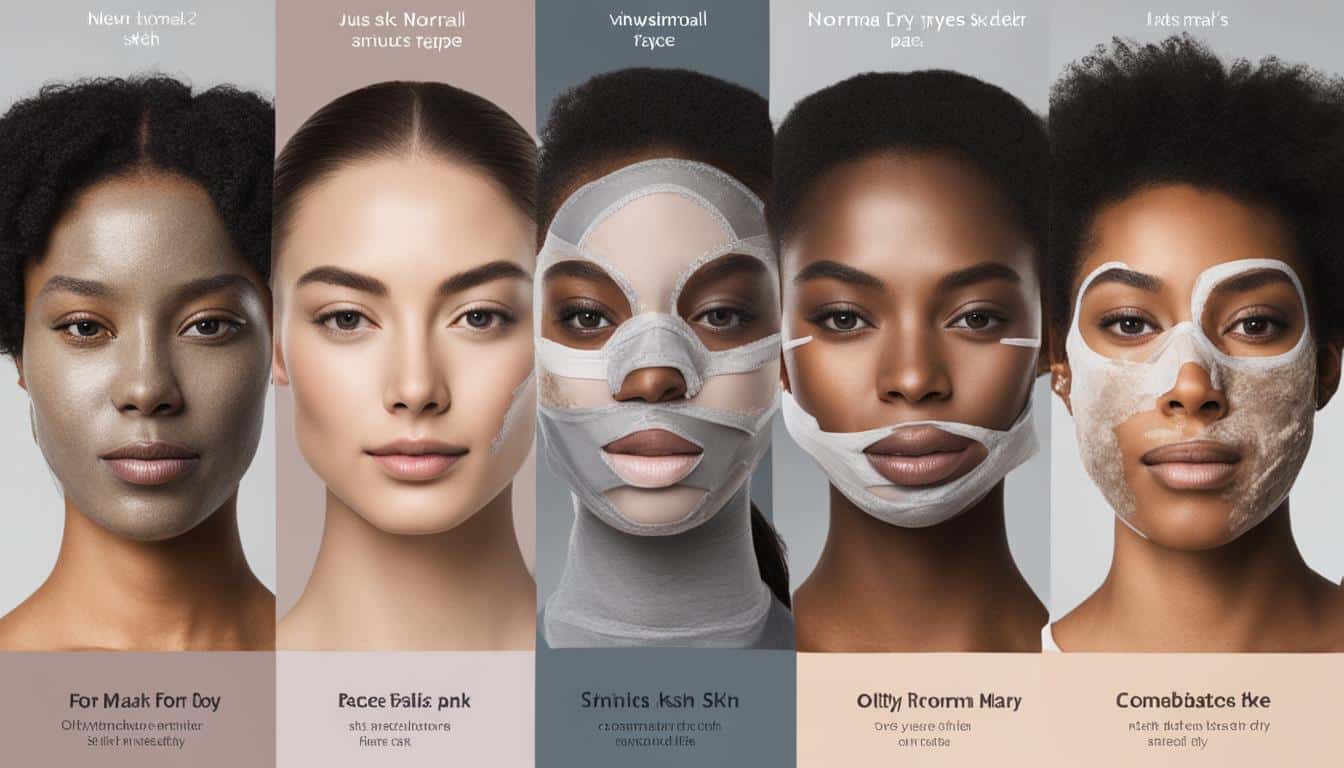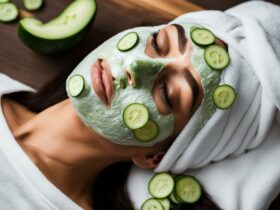Face masks have become a popular skincare trend due to their ability to improve the skin in various ways. Dermatologists recommend using face masks once a week to once a day, depending on your skin type and needs. There are different types of face masks available, including sheets, creams, gels, mud, and clay masks, each providing unique benefits. It’s essential to choose a mask that suits your skin type and to follow the proper application guidelines for optimal results.
Key Takeaways:
- Face masks should be used once a week to once a day, depending on your skin type and needs.
- Choose a face mask that suits your skin type.
- Follow the proper application guidelines for optimal results.
- There are different types of face masks available, each providing unique benefits.
- Using face masks can improve the overall health and appearance of the skin.
How to Apply Different Types of Face Masks
When it comes to applying face masks, the technique varies depending on the type of mask you’re using. Each mask has its own unique benefits and requires a specific application method to ensure optimal results. Whether you’re using cream masks, sheet masks, clay masks, or overnight masks, here’s a guide on how to apply them correctly.
Cream Masks:
Cream masks are typically applied in an even layer using your fingertips. Start by cleansing your face and then apply the mask, making sure to avoid the sensitive areas around your lips, eyes, and eyebrows. Massage the mask into your skin using gentle circular motions, allowing it to penetrate for the recommended amount of time.
Sheet Masks:
Sheet masks are convenient and easy to use. Simply unfold the mask and align it with your face, ensuring that the holes for your eyes, nose, and mouth are in the right place. Gently press the mask onto your skin to ensure even adherence. Leave it on for the recommended duration, allowing the mask’s essence to penetrate and nourish your skin.
Clay or Mud Masks:
Clay or mud masks are great for deep cleansing and detoxifying the skin. Start by cleansing your face and then apply the mask in a thin, even layer. Begin at the neck and work your way upward, making sure to cover your entire face. Leave the mask on for the recommended time and then rinse it off with lukewarm water.
Overnight Masks:
Overnight masks are designed to be left on your skin overnight, providing long-lasting hydration and nourishment. Apply a thin layer of the mask onto your cleansed face and neck, making sure to avoid the eye area. Leave it on overnight and rinse it off in the morning as part of your regular skincare routine.
| Type of Face Mask | Application Method |
|---|---|
| Cream Masks | Apply an even layer using fingertips, avoiding the eyes, lips, and eyebrows. |
| Sheet Masks | Unfold and align with the face, gently pressing to ensure even adherence. |
| Clay or Mud Masks | Spread evenly across the face, starting from the neck and moving upward. |
| Overnight Masks | Apply a thin layer and leave it on overnight, rinsing it off in the morning. |
How to Remove a Face Mask
Properly removing a face mask is crucial to ensure the effectiveness of the mask and prevent any potential skin irritation. Here are the recommended steps for removing different types of face masks:
Rinse-off Masks:
Rinse-off masks should be gently rubbed off with lukewarm water. Start by splashing water onto your face to soften the mask, then use your fingertips to gently massage in circular motions. Rinse thoroughly until all traces of the mask are removed, and pat your face dry with a clean towel.
Sheet Masks and Peel-off Masks:
Sheet masks should be carefully peeled off the face, taking your time to avoid any forceful pulling that could irritate the skin. Start by gently lifting the edges of the mask from the face, then slowly peel it off, working your way from the forehead down to the chin. After removing the mask, gently massage any excess serum into the skin or rinse with lukewarm water if instructed by the product.
Overnight Masks:
Unlike other masks, overnight masks are designed to be left on the skin and do not require rinsing. After wearing the mask overnight, simply proceed with your regular skincare routine in the morning. Cleanse your face, apply toner, and follow with moisturizer and sunscreen.
By following these proper mask removal techniques, you can ensure that your skin stays healthy and gets the maximum benefits from your face mask.
| Type of Mask | Removal Method |
|---|---|
| Rinse-off Masks | Gently rub off with lukewarm water and pat dry. |
| Sheet Masks and Peel-off Masks | Carefully peel off, starting from the forehead down to the chin. |
| Overnight Masks | No rinsing required. Proceed with regular skincare routine in the morning. |
Prepping and Aftercare for Face Masks
Proper prepping and aftercare routines are essential to maximize the benefits of using face masks. By following these steps, you can ensure that your skin is prepared for the mask and that it continues to stay nourished and healthy even after the mask is removed.
Prepping Your Skin
Before applying a face mask, it’s important to cleanse your skin thoroughly. Use a gentle facial cleanser to remove any dirt, oil, or makeup that may be on your face. This will create a clean canvas for the mask to work its magic. Once your skin is clean, pat it dry with a soft towel, leaving it slightly damp.
Next, it’s time to apply the mask. Depending on the type of mask you’re using, follow the instructions provided on the packaging. Some masks may require you to apply a thin layer, while others may need to be spread evenly across your face. Take your time and ensure that the mask is applied evenly, avoiding the sensitive areas around your eyes and lips.
Aftercare for Healthy Skin
Once you’ve removed the mask, it’s important to moisturize your skin to lock in the benefits of the treatment. Choose a moisturizer that is suitable for your skin type, whether it’s dry, oily, or sensitive. Gently massage the moisturizer into your skin using upward circular motions.
In addition to moisturizing, don’t forget to continue with your regular skincare routine. This may include applying serums, eye creams, or any other products that you typically use. By maintaining a consistent skincare routine, you can ensure that your skin remains healthy and radiant long after using a face mask.
DIY Face Mask Recipes
If you prefer using ingredients at home instead of purchasing face masks, there are several DIY recipes you can try. Making your own face masks allows you to customize the ingredients to suit your skin’s needs and preferences. Plus, it’s a fun and cost-effective way to pamper yourself. Here are three homemade face mask recipes that you can easily make:
1. Avocado and Cocoa Mask
This hydrating mask is perfect for dry or dehydrated skin. Avocado is rich in antioxidants and healthy fats, while cocoa powder provides nourishment and adds a subtle glow to the skin. To make this mask, mash half a ripe avocado, mix it with a tablespoon of cocoa powder, and add a teaspoon of honey for extra hydration. Apply the mixture to your face and leave it on for 15-20 minutes before rinsing off with warm water.
2. Egg and Oatmeal Mask
If you have oily or acne-prone skin, this mask can help control oiliness and reduce the appearance of blemishes. Egg yolk helps tighten the pores, while oatmeal exfoliates and soothes the skin. To make this mask, mix one egg yolk, a tablespoon of honey, a teaspoon of olive oil, and two tablespoons of oatmeal. Apply the mixture to your face and leave it on for 15 minutes before rinsing off with lukewarm water.
3. Orange Honey Mask
This brightening mask is ideal for dull or tired-looking skin. Oranges are packed with vitamin C, which helps promote a radiant complexion, while honey provides moisturization and has antibacterial properties. To make this mask, mix two tablespoons of orange juice with a tablespoon of honey. Apply the mixture to your face and leave it on for 10-15 minutes before rinsing off with cool water.
These homemade masks are easy to make and use natural ingredients that are readily available in most kitchens. Experiment with different combinations to find the ones that work best for your skin. Remember to patch test any new ingredients to ensure you don’t have any allergies or reactions. Enjoy the process of creating your own personalized skincare treatments!
Recommended Products for Different Skin Types
When it comes to choosing face masks, selecting the right product for your specific skin type is crucial. Different skin types have different needs, and using the appropriate mask can help address those needs effectively. Here are some recommended face masks for different skin types:
Dry Skin:
| Product | Description |
|---|---|
| Pure Radiance Cream Mask by Renée Rouleau | A hydrating mask that replenishes moisture and boosts radiance for dry skin. |
| Olay Regenerist Retinol 24 | A retinol-infused mask that helps improve skin texture and reduce fine lines and wrinkles. |
Oily or Combination Skin:
| Product | Description |
|---|---|
| DDF Sulfur Therapeutic Mask | A mask formulated with sulfur to help control excess oil and target blemishes. |
| Kiehl’s Rare Earth Deep Cleansing Pore Mask | A deep-cleansing mask that helps minimize the appearance of pores and control oil. |
Acne-Prone Skin:
| Product | Description |
|---|---|
| Peter Thomas Roth Pumpkin Enzyme Mask | An exfoliating mask infused with pumpkin enzymes to help smooth and clarify the skin. |
| Fresh Umbrian Clay Purifying Mask | A purifying mask enriched with Umbrian clay to help detoxify and balance the skin. |
Sensitive Skin:
| Product | Description |
|---|---|
| Fresh Rose Face Mask | A gentle mask infused with real rose petals to hydrate and soothe sensitive skin. |
| Belif Aqua Bomb Sleeping Mask | A lightweight overnight mask that provides intense hydration without causing irritation. |
These recommended products are just a starting point in finding the right face mask for your skin type. It’s important to consider your specific skin concerns and consult with a dermatologist if needed. With the right mask, you can give your skin the care it deserves and achieve a healthier, glowing complexion.
Conclusion
Properly using face masks is essential for optimal face mask usage and achieving desired skincare benefits. By following the recommended tips and incorporating face masks into your skincare routine, you can enhance the effectiveness of the mask and promote healthier, more radiant skin.
Understanding how much face mask to use is the first step. Dermatologists suggest using face masks once a week to once a day, depending on your skin type and needs. It’s important to choose a mask that suits your skin type and to follow the proper application guidelines for best results.
Applying different types of face masks correctly is crucial. The method of application varies depending on the type of mask. From cream masks to sheet masks, clay masks to gel masks, each type requires a specific technique to ensure even adherence and optimal benefits.
Once the recommended time has passed, removing the face mask properly is essential. Whether it’s rinsing off, gently peeling, or simply allowing overnight masks to absorb, taking care during the removal process helps prevent skin irritation and maintains the effectiveness of the mask.
Incorporating prepping and aftercare routines into your face mask regimen can further enhance the results. Cleansing the skin before application helps remove impurities, and moisturizing afterwards maintains hydration and maximizes the mask’s benefits.
If you prefer a cost-effective alternative, there are homemade face mask recipes you can try using ingredients at home. Avocado and cocoa, egg and oatmeal, and orange and honey are just a few examples of DIY options to explore.
Remember to consult with a dermatologist for personalized advice based on your specific skin concerns. With the right knowledge and approach, you can make the most of face masks and achieve healthier, more beautiful skin.
FAQ
How often should I use a face mask?
Dermatologists recommend using face masks once a week to once a day, depending on your skin type and needs.
What are the different types of face masks available?
There are different types of face masks available, including sheets, creams, gels, mud, and clay masks, each providing unique benefits.
How should I apply cream masks?
Cream masks should be applied in an even layer using fingertips, avoiding the lips, eyes, and eyebrows.
How should I apply bubble masks?
Bubble masks require applying a quarter-sized amount over the face, keeping it away from the eyes and lips.
How should I apply sheet masks?
Sheet masks should be carefully unfolded and aligned with the face, gently pressing to ensure even adherence.
How should I apply clay or mud masks?
Clay or mud-based masks should be spread evenly across the face, starting from the neck and moving upward.
How should I apply gel masks?
Gel masks can be applied using fingertips.
How should I apply overnight masks?
Overnight masks should be applied in a thin layer.
How long should I leave a face mask on?
Most face masks should be worn for no more than 20 minutes, except for overnight masks.
How do I remove rinse-off masks?
Rinse-off masks should be gently rubbed off with lukewarm water and patted dry.
How do I remove sheet masks and peel-off masks?
Sheet masks and peel-off masks should be carefully peeled off the face, taking your time and avoiding any forceful pulling.
What should I do after using an overnight mask?
Overnight masks do not require rinsing and can be followed by your regular skincare routine.
How do I prepare my skin before applying a face mask?
Cleansing the skin with a suitable facial cleanser helps remove impurities and allows the mask’s active ingredients to penetrate effectively.
Should I moisturize my skin after removing a face mask?
Moisturizing the skin while it’s still damp after removing a mask helps maintain hydration and enhances the mask’s benefits.
Are there any homemade face mask recipes I can try?
Yes, you can try homemade face mask recipes such as the avocado and cocoa mask, the egg and oatmeal mask, and the orange honey mask.
Which face masks are recommended for specific skin types?
For dry skin, the Pure Radiance Cream Mask by Renée Rouleau and Olay Regenerist Retinol 24 are recommended. For oily or combination skin, DDF Sulfur Therapeutic Mask and Kiehl’s Rare Earth Deep Cleansing Pore Mask are suitable. For acne-prone skin, Peter Thomas Roth Pumpkin Enzyme Mask and Fresh Umbrian Clay Purifying Mask work well. For sensitive skin, Fresh Rose Face Mask and Belif Aqua Bomb Sleeping Mask are gentle options.
How can I ensure proper face mask usage?
By understanding how much face mask to use, applying it correctly, and following proper removal and aftercare steps, you can enhance the effectiveness of the mask and prevent skin issues.
Please note that the HTML tags are not visible here but they should be included in the code.





